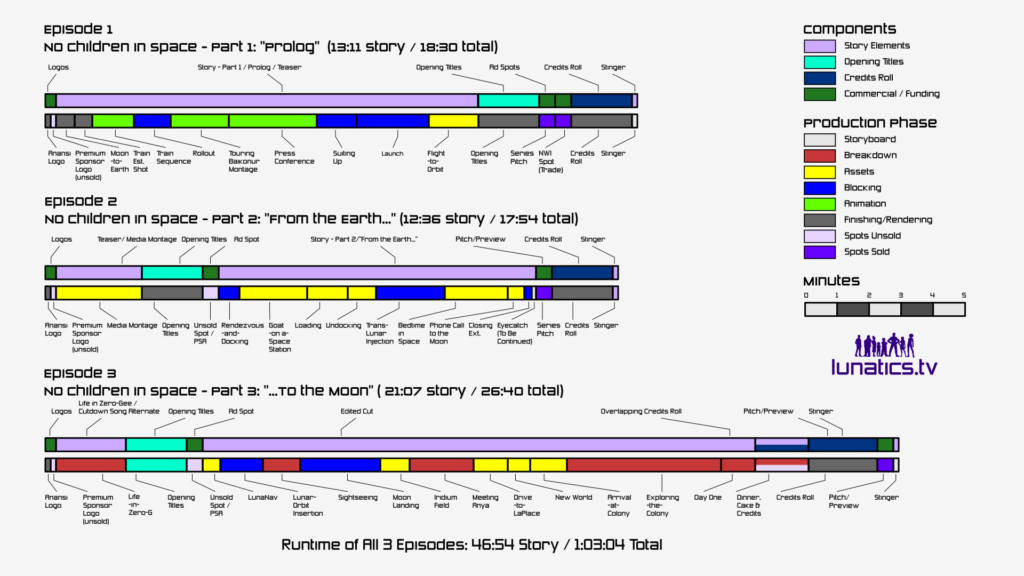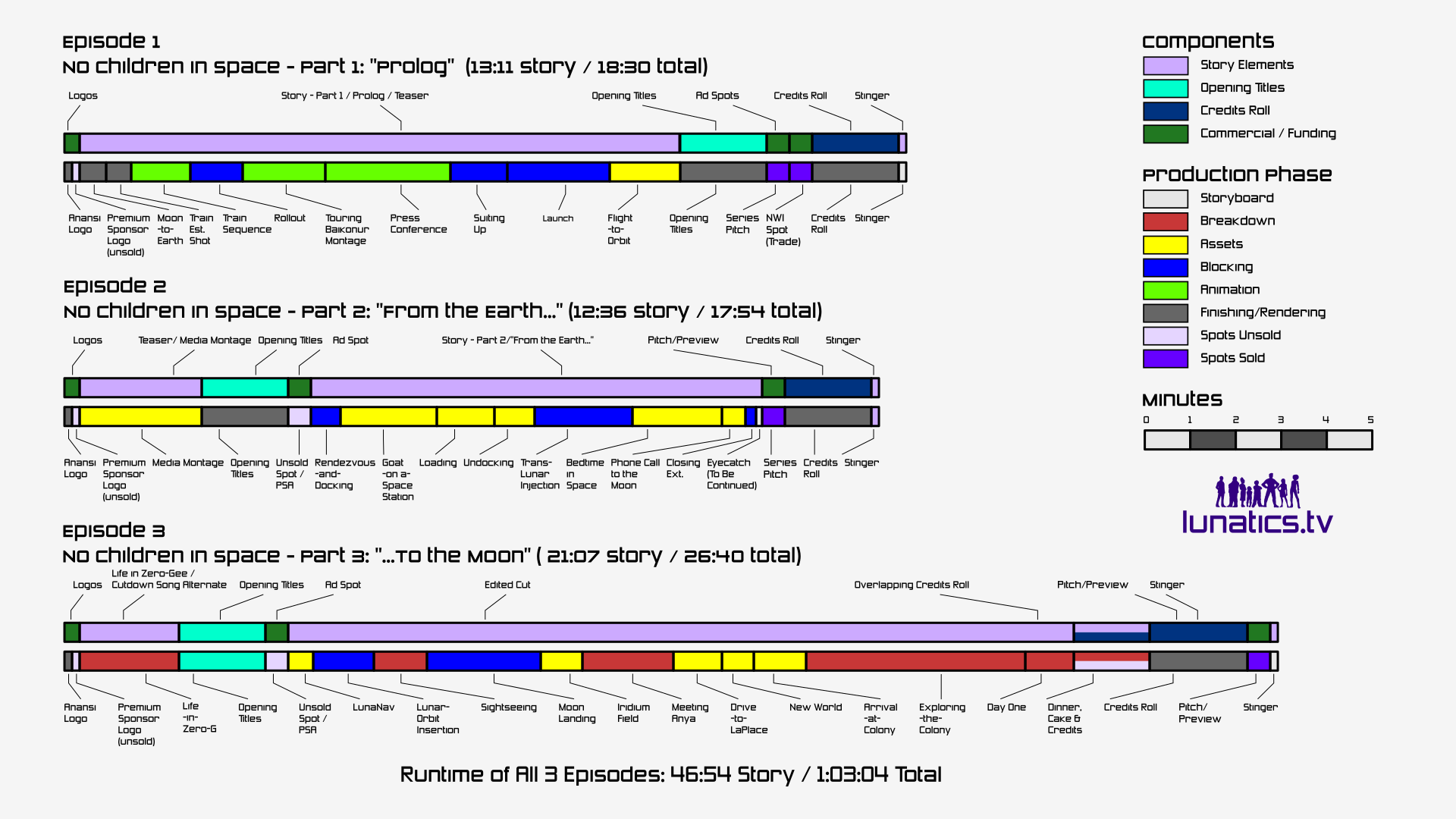We’ve gone through many revisions of the episode structure and requirements for our pilot episode, including breaking it up into three episodes instead of one, at least for the initial release through Vimeo and Patreon.
As this is no doubt confusing, it seems like a good idea to make a chart. It’s also an opportunity to review, scene-by-scene and classify how far along each is in production.

Names
The pilot story (all three episodes, or a combined omnibus) is called “No Children in Space”. The individual episodes, as broken down here, have been called variously:
- Episode 1 / NCiS – Part 1 / “Prolog”
- Episode 2 / NCiS – Part 2 / “From the Earth…”
- Episode 3 / NCiS – Part 3 / “…To the Moon”
If we keep the three-episode arrangement past the Patreon release schedule, I will probably adopt the individual episode names, rather than calling them parts 1, 2, and 3 of “No Children in Space”, but I’m not decided on that yet. “No Children in Space” could instead work as the title of Part 1 by itself, but right now, that just seems really confusing!
Story Revisions
Mostly, the 2nd and 3rd parts are represented by the storyreel cut that I released in 2012. As a result, there might be changes in length. I did make a small change to the beginning of the 3rd part that might give it a much more memorable teaser, but that depends on an unresolved licensing issue for the music I’d like to use (I hope to use completion of the 1st and 2nd parts to convince the artist we’re worth it, so that’ll remain unresolved until then).
An episode 2 teaser is actually quite nice, since the beginning of episode 2 was originally an alternate idea for the pilot’s teaser, before we decided to dramatize the launch explicitly. As the teaser for episode 2, it serves as a quick recap, while also providing the social context and exposition that it was meant to do.
Episode 1 originally was written as a really long teaser, and ends where the titles are supposed to begin in the original script. I think the only practical way to do it as a separate episode, is to just put the main title at the end, where it was originally planned to go, and then just run the end-matter directly after that. Doesn’t hurt that this has been a popular trend in movies lately.
Production Phases
To make this diagram, I’ve color-coded the production phases, which I broke down into a series of stages:
- Script/Storyboard/Storyreel
- Breakdown
- Asset Development
- Blocking
- Animation
- Effects/Finishing/Rendering
We start with a script, of course, visualize shots and sequences with storyboards, and create a storyreel in the pre-production phase. Then we have to do an analysis of that sequence: what do we need to make to animate it? That’s the “Breakdown” phase.
After that, we have to do modeling, rigging, materials, and texture work in Blender to create the sets, props, and characters required for the shots — that’s “Asset Development”. This is the bulk of the production work, especially at the beginning, and several people have contributed to this work, including Chris Kuhn for mech models and rigging, Andrew Pray, Bela Szabo, and Keneisha Perry for character modeling (although Keneisha has done most of the character modeling since 2015), and Keneisha for wardrobe rigging, etc. We also had sets and props created by Sathish Kumar, Travis Souza, and Jonathon Wilson, and a few other contributions.
Then we do “Blocking”, which is basically recreating our storyreel with still images and pre-vis animations: the idea is to figure out in detail what the shots, compositing, and so on for each sequence will be — as a director I do a fair amount of revision in this step, working kind of like a live-action director picking shots. Sometimes much better arrangements than we storyboarded will become apparent to me as I work in Blender. Once we know just what we want, we need to go into “Animation”. For us, there are basically two classes of animation: “Mech” animation, which is mostly me, and “Character” animation which is mostly being done by Keneisha.
Finally, of course, there is “Finishing” the lighting, effects, compositing, editing, and other details to get the renders just right, and then the rendering itself, which can be a slow process in itself. At the same time, there is sound recording and mixing. The early parts of that were finished in 2012, including all the voice recording. But in the finishing stage, we’ll be completing the last phases: foley sound and mixing for stereo and 5.1 sound systems.
The finished episodes have some additional material for distribution: logos, sponsor-logos, ad/psa spots, etc. For example, in the first episode, we are going to include a 30s “pitch video” to direct viewers to the Patreon page to help us finish the story. We also made a deal to include a short promotional for the annual “New Worlds Institute” conference in Austin in exchange for exhibit space there in 2015, so we’ll be including that. There’s also a leading-logo spot for an “episode sponsor” if we are lucky enough to get one, although that’s probably a long shot on the first episode. These are just marked as either “sold” or “unsold” on the production phase diagram, and in green (for money!) on the components diagram.
Details
For simplicity, I had to pick a single “production phase” for each scene, even though each scene has it’s own little behind-the-scenes story behind it with its own challenges. I’ve tried to pick the phase that gives the most accurate impression, but there are complications. For example, Keneisha has indeed been working on animation for the “Touring Baikonur” montage, but that sequence also has some asset development work that I need to do — basically “set dressing”, even though the basic sets have been created. That’s nothing really hard — but a lot of detailed tweaking for several very short shots together.
I just finished the asset development work needed for the “Rollout” and “Launch” sequences, so while they are technically ready for blocking, I haven’t done very much blocking yet — I had done some previs work on them already, though, so I’m pretty clear on what’s going into them. The “Flight-to-Orbit” sequence, on the other hand, is very close to being ready to do the blocking work, but I’m still working on re-rigging the flight version of the Soyuz. That’s my main Blender project for this coming week. These scenes have very little character animation in them, since the characters are strapped into acceleration couches for most of them.
The “Suiting Up” scene, on the other hand, requires a fair amount of character work. The big character animation sequence in the first episode, though, is the “Press Conference”, which involves character dialog, movements, and so on. To get this done, we decided we needed to build a better computer for Keneisha, which is what that was about. It’s also going to be a bear to render, as there is a lot of moving camera, and so it’s not easy to do with compositing. We could have avoided this, but we did it as a demonstration of technique and a learning experiment. It’s one of the most technically challenging things we’ve attempted, and I think it’s going to look pretty good.
Of course, at any point, a sequence can get bumped back to an earlier phase if we decide we don’t like how it’s working out. Much of Episode three has gone back to the “Breakdown” phase, and so it’s quite possible there will be some changes there. The lengths illustrated here are based on the current length in the storyreel for shots that have not got to the blocking phase.


